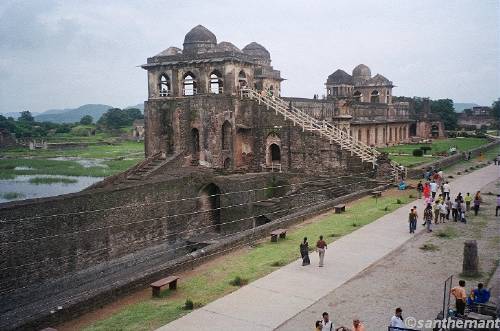Mandu Travel Guide:

Introduction
Mandu is a ruined city in the Dhar district in the Malwa region of western Madhya Pradesh state, central India. The distance between Dhar & Mandu is about 35 km. In the 11th century, Mandu was the sub division of the Tarangagadh or Taranga kingdom . This fortress town on a rocky outcrop about 100 km (60 miles) from Indore is celebrated for its fine architecture.
History
Mandu's was earlier known by the name of "Shadiabad" meaning the city of happiness (Anand Nagari), the name was given by then ruler Allauddin Khilji. Mandu city is situated at an elevation of 633 metres (2079 feet) and extends for 13 km (8 miles) along the crest of the Vindhya Range, overlooking the plateau of Malwa to the north and the valley of the Narmada River to the south. These acted as natural defences and Mandu was originally the fort-capital of Rajput Parmara rulers of Malwa. Towards the end of the 11th century, it came under the sway of the Taranga kingdom.
In the 10th century Mandu was founded as a fortress retreat by Raja Bhoj. It was conquered by the Muslim rulers of Delhi in 1304. When, in 1401, the Mughals captured Delhi, the Afghan Dilawar Khan, governor of Malwa, set up his own little kingdom and the Ghuri dynasty was established. And thus began Mandu's golden age.
Places of interest
Mandu, due to its strategic position and natural defences, was an important place with a rich and varied history. It was an important military outpost and its military past can be gauged by the circuit of the battlemented wall, which is nearly 37 km (23 miles) and is punctuated by 12 gateways. The wasll encloses a large number of palaces, mosques, Jain temples of 14th century and other buildings. The oldest mosque dates from 1405; the finest is the Jama Masjid or great mosque, a notable example of Pashtun architecture. The marble domed tomb of this ruler is also magnificent.
Hindola Mahal
Hindola Mahal - meaning Swing palace is so named due to its sloping side walls. The Hindola Mahal might have been constructed during the reign of Hushang Shah about 1425 C.E. but may date to the end of the 15th century during the reign of Ghiyas al-Din. It is one of a set buildings making up the royal palace complex at Mandu, which consists of the Jahaz Mahal, the Hindola Mahal, the Tawili Mahal, and the Nahar Jharokha. The Hindola Mahal may have been used as an audience chamber. There are a number of other, undated structures surrounding the palace - an evidence of the rich and glorious past.